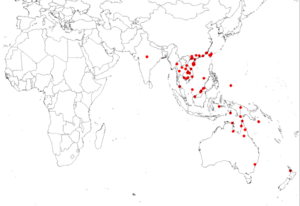Tropical sundew facts for kids
Quick facts for kids Tropical sundew |
|
|---|---|
 |
|
| Drosera burmannii | |
| Scientific classification | |
| Genus: |
Drosera
|
| Species: |
burmannii
|
 |
|
| Occurrence data from AVH and GBIF | |
| Synonyms | |
|
|
The Drosera burmannii, also known as the tropical sundew, is a small and amazing carnivorous plant. It belongs to the Drosera family. This plant is tiny, usually only about 2 centimeters (less than an inch) wide.
You can find the tropical sundew in warm, sunny places around the world. It grows naturally in tropical and subtropical parts of Asia, Australia, India, Japan, Southeast Asia, Oceania, Africa, and various regions of China.
This sundew is famous for being one of the fastest insect traps! Its leaves can quickly curl around a bug in just a few seconds. Other sundews might take minutes or even hours to catch their prey.
In nature, D. burmannii usually lives for about a year. But if people grow it indoors during cold weather, it can live for many years. Since it's an annual, it makes lots of seeds to help new plants grow.
About the Tropical Sundew
The Drosera burmannii is a small plant with very short stems. Its leaves grow in a circular shape, like a rosette. Each leaf looks like a wedge and is about 8 to 10 millimeters long and 5 to 6 millimeters wide.
This plant produces pretty white flowers. These flowers grow in groups of 3 to 10 on tall stalks. These stalks can be 6 to 15 centimeters (about 2 to 6 inches) high. A single plant can have one to three of these flower stalks.
How the Tropical Sundew Was Discovered
The first short description of the tropical sundew was written by Paul Hermann. His work was published after he died by William Sherard.
Later, in 1737, Johannes Burman wrote more about this plant. He described it in his book about the plants of Ceylon. Burman gave the plant a long name, but it wasn't its official scientific name yet.
The plant finally got its official name in 1794. Martin Vahl named it Drosera burmanni to honor Johannes Burman. The name is usually spelled burmannii today.
In 1871, a scientist named Heinrich Gustav Reichenbach described a new plant. He called it D. dietrichiana, named after the person who found it, Amalie Dietrich. However, in 1906, another scientist named Ludwig Diels decided that D. dietrichiana was actually just a type of D. burmannii. He said it was a larger and stronger version. Today, both D. dietrichiana and that special type are considered the same as D. burmannii.
See also
 In Spanish: Drosera burmannii para niños
In Spanish: Drosera burmannii para niños

